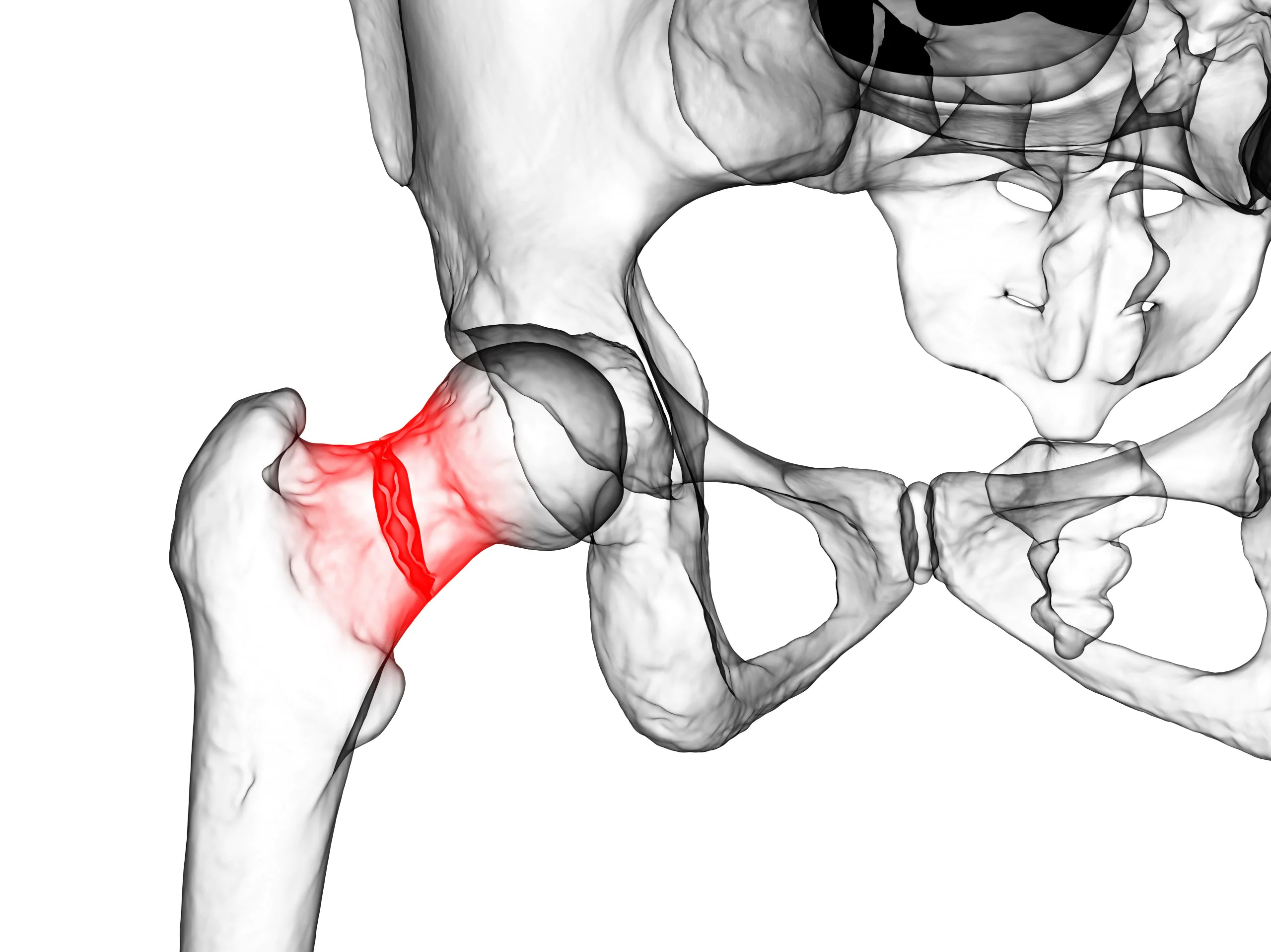Hip fractures are a significant health concern affecting millions of people worldwide each year. Whether due to falls, accidents, or underlying medical conditions, these injuries can have profound impacts on mobility, independence, and overall quality of life. In this comprehensive guide, we delve into the various aspects of hip fractures, from their causes and risk factors to treatment options and recovery processes.
This guide will also show how individuals who have suffered hip injuries due to negligence can secure long-term financial stability and relief through a personal injury settlement (skip to this section using the table of contents below).
Anatomy and Physiology of the Hip Joint
The hip joint, a complex ball-and-socket joint, comprises the femoral head and the acetabulum of the pelvis. Its intricate anatomy and biomechanics enable a wide range of movements while maintaining stability and supporting body weight. Ligaments, tendons, muscles, and cartilage structures surrounding the hip joint play pivotal roles in ensuring its functionality and structural integrity.
Types of Hip Fractures
Hip fractures, characterized by a break in the proximal end of the femur, present a spectrum of challenges in diagnosis, treatment, and recovery. These fractures are classified into intracapsular, extracapsular, and periprosthetic fractures, each with distinct clinical presentations and management considerations. Understanding the underlying mechanisms and risk factors associated with hip fractures is paramount for effective management and prevention.
Intracapsular Hip Fractures
Intracapsular hip fractures occur within the hip joint capsule, primarily involving the femoral neck or transcervical region. These fractures disrupt the structural integrity of the femoral head and neck, often due to mechanical forces applied during falls or trauma. Their location within the joint capsule can impact blood supply to the femoral head, potentially leading to complications such as avascular necrosis.
Extracapsular Hip Fractures
Extracapsular hip fractures occur outside the hip joint capsule, predominantly affecting the intertrochanteric or subtrochanteric region of the femur. These fractures often result from high-energy trauma or pathological conditions such as osteoporosis, leading to weakening of the bone structure. Compared to intracapsular fractures, extracapsular fractures may involve more extensive soft tissue damage and have a higher risk of complications such as nonunion or malunion.
Acetabular Fractures
These fractures occur when the socket portion of the hip joint disrupts the bony structure that articulates with the femoral head. These fractures can vary in severity and complexity, often resulting from high-energy trauma such as motor vehicle accidents or falls from height.
Periprosthetic Fractures
Periprosthetic fractures occur in the vicinity of hip implants, affecting the bone-implant interface and posing unique challenges in management. These fractures can result from trauma, implant loosening, or stress-related factors, compromising the stability and integrity of the prosthetic construct. Diagnosis involves careful assessment of implant positioning, bone quality, and fracture characteristics through imaging studies and clinical evaluation.
Leading Causes of Hip Fractures in the US
Hip fractures can result from a variety of causes, including falls, osteoporosis, trauma, and underlying medical conditions. The leading causes of hip fractures in the US include:
- Falls: the leading cause of hip fractures, particularly among older adults, due to age-related changes in balance, muscle strength, and bone density.
- Osteoporosis: this condition is characterized by reduced bone mass and increased fracture risk, significantly increasing the risk of hip fractures.
- Traumatic injuries such as motor vehicle accidents, is the third-leading cause of hip fractures in the country. Head-on collisions, t-bone accidents, and rear-end accidents account for most of these injuries. Air bags have also been known to cause hip injuries, as even though they absorb much of an impact, the sudden force of inflation can cause damage to the hips and ribs.
- Certain medical conditions such as cancer or metabolic disorders weaken bones, increasing susceptibility to fractures.
Hip Fracture Recovery Times and Treatment
Recovery from a hip fracture is a complex process influenced by various factors, including the type and severity of the fracture, the patient’s overall health and functional status, the chosen treatment approach, and any complications that may arise during the recovery process. In this section, we’ll explore general recovery times for hip fractures, along with factors that contribute to these timelines, and discuss which types of hip injuries tend to heal the fastest and the slowest.
Factors That Affect Recovery Time
- Fracture Severity: The severity of the fracture, including factors such as displacement, comminution, and involvement of surrounding structures, can impact recovery times. More severe fractures may require surgical intervention and prolonged rehabilitation.
- Patient Age and Health: Older adults and individuals with underlying health conditions such as osteoporosis or chronic diseases may experience slower healing and longer recovery times. Poor overall health can also increase the risk of complications and delay rehabilitation progress.
- Treatment Approach: The chosen treatment approach, whether conservative management or surgical intervention, can influence recovery times. Surgical procedures may require longer initial recovery periods but can lead to improved long-term outcomes in some cases.
- Complications: The presence of complications such as infection, implant failure, or nonunion can significantly prolong recovery times and necessitate additional interventions.
- Rehabilitation Compliance: Adherence to rehabilitation protocols, including physical therapy exercises and activity modifications, is essential for optimizing recovery outcomes. Patients who actively participate in rehabilitation may experience faster recovery times compared to those who do not.
Fastest-Healing Hip Injuries
Intracapsular hip fractures, particularly those that are stable and well-aligned, tend to heal relatively quickly compared to other types of hip fractures. Conservative management with immobilization may be sufficient for these fractures, leading to shorter recovery times in some cases.
Slowest-Healing Hip Injuries
Complex fractures such as periprosthetic fractures or acetabular fractures, which involve extensive soft tissue damage or intra-articular involvement, tend to have longer recovery times. These fractures often require surgical intervention and prolonged rehabilitation to achieve optimal outcomes.
What to Do After Suffering a Hip Fracture
- Seek Diagnosis and Treatment: The first step in the recovery process is obtaining an accurate diagnosis from a qualified healthcare professional. This often involves a comprehensive physical examination, imaging studies such as X-rays or MRI scans, and possibly diagnostic injections to pinpoint the exact nature and extent of the injury. Once diagnosed, the treatment plan may include a combination of rest, physical therapy, medication, and in some cases, surgery to repair or reconstruct damaged tissues.
- Rest and Recovery: Rest is a crucial component of the initial recovery phase, allowing injured tissues to heal and inflammation to subside. Depending on the severity of the injury, rest may involve partial or complete immobilization of the hip joint, using crutches or a walker to offload weight, and avoiding activities that exacerbate pain or discomfort. Adequate rest and proper nutrition are essential for supporting the body’s natural healing processes and promoting tissue repair.
- Physical Therapy and Rehabilitation: As healing progresses, physical therapy plays a pivotal role in restoring strength, flexibility, and function to the injured hip. A skilled physical therapist will develop a personalized rehabilitation program tailored to the individual’s specific needs and goals. This may include exercises to improve range of motion, strengthen hip muscles, and enhance balance and proprioception. Gradually, the focus shifts towards functional activities and sports-specific training to prepare for a return to normal activities or sports.
- Patience and Persistence: Recovering from a hip injury is often a gradual and iterative process that requires patience and persistence. Setbacks and challenges may arise along the way, but maintaining a positive attitude and staying committed to the recovery plan can help overcome obstacles. It’s essential to listen to your body, communicate openly with your healthcare team, and adjust your approach as needed to optimize outcomes and minimize the risk of reinjury.
- Return to Activity: As recovery progresses and symptoms subside, individuals may gradually reintroduce activities and exercises that were previously restricted. However, it’s crucial to progress slowly and gradually increase intensity and duration to avoid overloading the healing tissues. Working closely with a physical therapist or sports medicine specialist can provide guidance on safe progression and help monitor for any signs of recurring pain or dysfunction.
- Prevention and Long-Term Wellness: Once recovery is complete, focusing on prevention and long-term wellness becomes paramount. This may include maintaining a regular exercise routine to keep hip muscles strong and flexible, incorporating proper warm-up and cool-down protocols before physical activity, and implementing strategies to reduce the risk of future injuries, such as wearing supportive footwear and using proper body mechanics during activities.
- Long-Term Monitoring: Following recovery from a fracture, long-term monitoring and follow-up are essential to assess implant integrity, joint function, and overall hip health. Regular evaluations by a healthcare provider, including periodic imaging studies and functional assessments, can help identify potential complications and intervene early to prevent adverse outcomes.
Hip Fractures Caused by Negligence: Understanding Your Rights
Being injured by negligence entails experiencing harm due to the failure of another party to exercise reasonable care, whether it’s a property owner neglecting to maintain safe premises, a driver ignoring traffic laws, or a healthcare provider making a medical error.
In such cases, pursuing a lawsuit against the negligent party is often advisable, as it provides a legal avenue for seeking compensation to cover all associated costs and ensure long-term financial stability. An injury settlement obtained through litigation can help alleviate the financial burden of medical expenses, lost wages, rehabilitation, and other damages, offering essential support to those affected by negligence-induced injuries.
Examples of Hip Fractures Caused by Negligence
- Slip and Fall Accidents: These accidents often happen on slippery surfaces, uneven walkways, or poorly lit areas where property owners have failed to take adequate safety measures.
- Car Accidents: Negligent driving behaviors such as speeding, distracted driving, drunk driving, or disregarding traffic laws can lead to collisions resulting in hip fractures.
- Medical Malpractice: Errors during surgery, misdiagnosis, medication errors, or failure to provide appropriate care can result in severe injuries, including hip fractures.
- Nursing Home Neglect: Inadequate supervision, neglect of basic needs, and failure to address mobility issues can contribute to falls and hip fractures among elderly residents in nursing homes.
Compensation for Damages
When you suffer a hip fracture due to negligence, you may be entitled to compensation for various damages, including:
- Medical Expenses: This includes hospital bills, surgery costs, medication expenses, rehabilitation fees, and any future medical treatment related to your injury.
- Lost Income: If your injury prevents you from working or requires you to take time off for recovery, you may be compensated for lost wages and earning capacity.
- Pain and Suffering: Physical pain, emotional distress, loss of enjoyment of life, and other non-economic damages may also be included in your compensation.
Hip Injury Settlements
When pursuing compensation for a hip injury caused by negligence, determining the value of a settlement is a complex process that involves evaluating various factors. While every case is unique, recent examples can provide insight into potential settlement amounts for hip injuries caused by negligence.
Factors Affecting Settlement Values
Several factors influence the value of a hip injury settlement, including:
- Severity of Injury: The extent of the hip injury, including factors such as fracture severity, complications, and long-term effects on mobility and quality of life, plays a significant role in determining settlement value.
- Extent of Damages: Damages resulting from the injury, such as medical expenses, lost wages, pain and suffering, rehabilitation costs, and future medical care needs, are considered when calculating settlement amounts.
- At-Fault Party’s Liability: The degree of responsibility or liability of the at-fault party for causing the hip injury is a crucial factor in determining settlement value.
- Pre-existing Conditions: Any pre-existing conditions or injuries that may have contributed to the hip injury or exacerbated its severity can impact the settlement value. If the at-fault party’s negligence worsened a pre-existing condition, the settlement may reflect this increased impact on the victim’s health.
- Age and Occupation: The age and occupation of the injured party can influence settlement calculations. Younger individuals with longer work-life expectancies may receive higher settlements to compensate for potential long-term effects on their ability to work and earn a living. Similarly, the nature of the victim’s occupation and the extent to which the injury affects their ability to perform job duties may be factored into the settlement.
- Future Medical Needs: Anticipated future medical expenses related to the hip injury, such as ongoing rehabilitation, specialized medical care, or assistive devices, are considered when determining settlement amounts. The severity of the injury and its long-term effects on the victim’s health and mobility play a significant role in estimating these future medical costs.
- Loss of Enjoyment of Life: Compensation for the loss of enjoyment of life accounts for the physical and emotional impact of the hip injury on the victim’s ability to engage in activities they previously enjoyed. This factor considers the limitations imposed by the injury on recreational pursuits, social interactions, and overall quality of life.
- Comparative Negligence: In cases where the injured party shares some degree of fault for the accident that caused the hip injury, the principle of comparative negligence may apply. Settlement amounts may be adjusted to reflect the percentage of fault assigned to each party involved in the incident.
- Pain and Suffering: Non-economic damages such as physical and emotional distress, as well as mental anguish are subjective but significant components of a hip injury settlement. Compensation for these intangible losses aims to address the physical discomfort, emotional trauma, and mental anguish experienced by the victim as a result of the injury and its aftermath.
Recent Settlement Amounts
While every case is unique, recent settlement amounts for hip injuries caused by negligence have included:
- Slip and Fall Accident: $500,000
In a slip and fall accident caused by negligent maintenance of a property, a victim suffered a hip fracture requiring surgery and extensive rehabilitation. - Auto Accident: $250,000
In a car accident caused by a distracted driver, a victim sustained a hip fracture and other injuries, resulting in significant medical expenses and long-term impairment. - Construction Site Accident: $300,000
A worker recently sustained a hip fracture due to a fall from scaffolding that lacked proper safety measures. The worker required surgery and extensive rehabilitation, resulting in significant medical expenses and loss of income. - Medical Malpractice: $100,000
A hospital patient suffered a severe hip injury due to surgical errors, resulting in permanent disability and the need for ongoing medical care. - Nursing Home Neglect: $150,000
In a case of nursing home neglect, an elderly resident suffered a hip fracture due to inadequate supervision and falls prevention measures, leading to pain and suffering and diminished quality of life.
Disclaimer: The above examples are for illustrative purposes only and do not guarantee similar outcomes. Names and details of each case have been changed to protect client privacy.
The Hip Injury Legal Process
The legal process for pursuing a hip fracture injury claim typically involves several key steps:
- Free Consultation: During an initial consultation, you’ll meet with a lawyer to discuss the details of your case, evaluate your legal options, and determine the best course of action.
- Investigation: Your lawyer will conduct a thorough investigation into the circumstances surrounding your injury, gathering evidence such as medical records, witness statements, and accident reports.
- Negotiation: Your lawyer will negotiate with the at-fault party’s insurance company or legal representatives to reach a fair settlement that adequately compensates you for your damages.
- Litigation: If a settlement cannot be reached through negotiation, your case may proceed to litigation, where a judge or jury will hear arguments from both sides and ultimately decide the outcome.
- Settlement: If a settlement is reached, your lawyer will ensure that the terms are fair and favorable to you before finalizing the agreement and disbursing the compensation.
Hip Injuries at Work
If your hip injury occurred at work, you may be eligible for worker’s compensation benefits to cover medical expenses and lost wages. A worker’s compensation lawyer can help you navigate the claims process, protect your rights, and ensure you receive the benefits you deserve.
Examples of Workplace Negligence Leading to Hip Fractures
Workplace environments can pose various hazards that, if not properly managed, can result in accidents leading to hip fractures. Here are some common examples of workplace negligence that may contribute to hip injuries:
- Unsafe Working Conditions: Failure to maintain a safe and hazard-free workplace can increase the risk of accidents. Examples include slippery floors, cluttered walkways, inadequate lighting, or unsecured equipment.
- Lack of Safety Protocols: Employers have a legal obligation to implement and enforce safety protocols to protect workers from harm. Neglecting to provide appropriate safety training, personal protective equipment (PPE), or ergonomic workstations can increase the likelihood of accidents and injuries.
- Defective Equipment: Malfunctioning or poorly maintained equipment can pose serious safety hazards. Employers are responsible for regularly inspecting and maintaining machinery, tools, and other equipment to ensure they are in safe working condition.
- Overexertion: Excessive physical exertion or repetitive motions without adequate rest breaks can lead to musculoskeletal injuries, including hip fractures. Employers should implement ergonomic practices and workload management strategies to prevent overexertion and fatigue among workers.
- Lack of Fall Protection: Jobs that involve working at heights, such as construction or roofing, require proper fall protection measures to prevent falls and serious injuries. Failure to provide adequate fall protection systems, such as guardrails, harnesses, or safety nets, can result in hip fractures and other traumatic injuries.
- Negligence in Vehicle Operations: Workers who operate vehicles or machinery as part of their job duties are at risk of accidents if proper safety protocols are not followed. This includes failure to maintain vehicles, reckless driving, or inadequate training for operating heavy machinery.
- Chemical Exposure: Exposure to hazardous chemicals or substances in the workplace can cause health problems, including bone density loss and increased susceptibility to fractures. Employers should provide appropriate safety measures, such as ventilation systems, protective clothing, and training on handling hazardous materials, to minimize the risk of chemical-related injuries.
Finding the Right Hip Injury Lawyer
Finding the right lawyer to represent your hip fracture injury case is crucial for achieving a favorable outcome. When choosing a lawyer, consider the following:
- Experience: Look for a lawyer with a proven track record of success in handling personal injury cases, particularly those involving hip fractures.
- Expertise: Seek out a lawyer who specializes in personal injury law and has extensive experience representing clients with similar injuries.
- Resources: Choose a law firm with the resources and capabilities to thoroughly investigate your case, gather evidence, and build a strong legal strategy.
- Communication: Opt for a lawyer who communicates openly and effectively, keeping you informed about the progress of your case and addressing any concerns you may have.
Contact a Hip Injury Lawyer
If you’ve suffered a hip fracture due to negligence, it’s essential to seek legal representation to protect your rights and pursue fair compensation for your damages. Contacting a hip injury lawyer can provide you with the guidance and support you need during this challenging time.
For a free consultation with a hip injury lawyer, you can call 855-468-7626 or contact us online. The hip fracture lawyers at Sobo & Sobo have over 50 years of experience winning for those who suffer hip injuries across New York, New Jersey, and Illinois, and are committed to helping you restore your quality of life.




